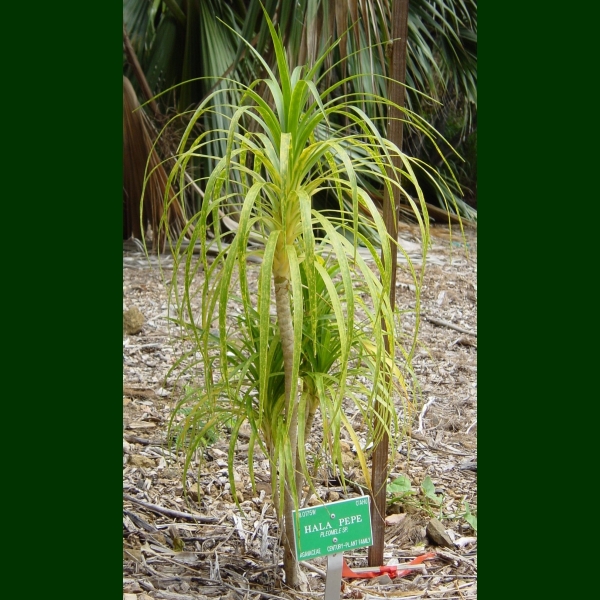 Hawaiian Name(s): hala pepe, ie‘ie, kuha‘o, ku la
Hawaiian Name(s): hala pepe, ie‘ie, kuha‘o, ku laScientific Name: Pleomele (6 species)
Vernacular Name: none
Family: Asparagaceae
Status: endemic
Authority: P. aurea (H.Mann) N.E.Br., P. auwahiensis H.St.John, P. fernaldii H.St.John, P. forbesii O.Deg., P. halapepe H.St.John, P. hawaiiensis O.Deg. & I.Deg.
Description: Trees 3-10m tall (monocots).
Habitat Six species: P. aurea on Kaua‘i in diverse mesic forests 120–1070m, P. auwahiensis on Maui & Moloka‘i in dry forest, occasionally in mesic forest 610–1220m, P. fernaldii on Lāni‘i, from 490-670m in dry forsts, P. forbesii 240–730m dry and diverse mesic forest (usu. Wai‘anae), P. halapepe dry forest to diverse mesic forest 180–610m.P. hawaiiensis in leewrad Hawai‘i in dry forest, occasionally mesic, 300–860m (Wagner et al. 1990:1351–1354).
Medicines: For the treatment of hu‘i, wela ikaika, wela kupuni (chills, high fever, etc.) the bark and leaves are use in combination with the root bark of ‘uhaloa (Waltheria indica) and pōpolo (Solanum americanum), and a section of kō kea (white sugarcane, Saccharum officinarum). For ni‘au (ke‘ewai, ‘e‘ewai, "lung trouble/asthma") the treatment includes the use of halapepe bark, root, and leaves, as well as ‘ōhi‘a ‘ai bark (Syzygium malaccense), ‘uhaloa and pōpolo tap root bark, ‘ala‘ala wai nui pehu (Peperomia spp.) stems, noni fruit (Morinda citrifolia), kō kea, niu (coconut, Cocos nucifera), and pia (Hawaiian arrowroot, Tacca leontopetaloides) (Chun 1994:77–79).
Non Medicinal Uses: Soft trunks carved into idols (Hillebrande 1888:443), branches used to decorate altars, including those for Laka (Little & Skomen 1989:86–7); this wood used to represent Kapo (also hula goddess) (Abbott 1992:118). Flowers for lei (Krauss 1993:77).
Specific gravity of wood: unknown
Famous Locations:
Mele:
`Ōlelo Noeau:
Dye Color and Parts:
Kino lau:
Location on Bishop Museum Kalihi Campus:
Propagation Information: Intermediate. Seeds sprout in 2-4 weeks, pot seedlings in moist, well-drained potting mixture once roots are 1 inch long; grow rapidly & like a little peat moss near soils surface; plantout when they reach 20-30cm in well drained soil; after 2-3 years need no watering (Culliney and Koebele 1999:57–59).
Hawaiian Native Plant Propagation Database.
Native Plants Hawaii.
Seed: Seed length approximately 6 mm. Photograph: B.Kennedy. Species: P. fernaldii.

